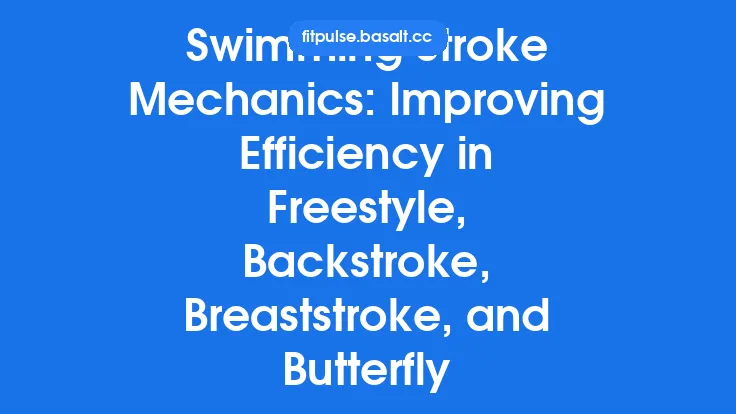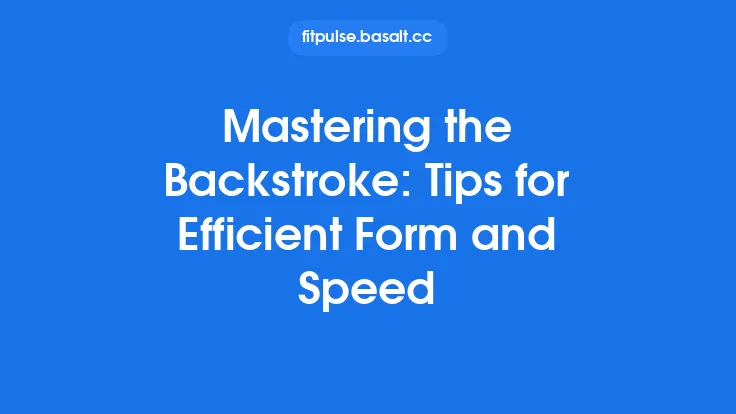Butterfly is often regarded as the most demanding of the competitive strokes, requiring a seamless blend of power, timing, and fluid rhythm. Mastering its mechanics means learning how to generate propulsion efficiently while maintaining a streamlined body position that minimizes drag. Below, we break down the essential components of the butterfly stroke, explore how to build the power needed for each phase, and provide practical cues and drills that help swimmers develop a consistent, race‑ready rhythm.
The Core Wave: Understanding the Body’s Undulating Motion
At the heart of butterfly lies a wave‑like movement that starts from the hips and travels through the torso, chest, and finally the arms. This undulation is not a random bounce; it is a coordinated sequence that allows the swimmer to convert core and lower‑body force into forward thrust.
Key Elements
- Hip Drive – The hips initiate the wave by pushing down and then snapping upward. Strong gluteal and hamstring activation creates the “kick” that propels the body forward.
- Chest and Shoulder Follow‑Through – As the hips rise, the ribcage lifts, and the shoulders move forward, setting the stage for the arm pull.
- Arm Timing – The arms must enter the water just as the body reaches its lowest point, allowing the swimmer to “catch” the water when the torso is most extended.
Why It Matters
A well‑timed wave reduces the need for excessive arm effort, conserves energy, and keeps the swimmer’s head in a neutral position, which is crucial for maintaining a low drag profile.
The Arm Pull: From Catch to Push
The butterfly arm cycle can be divided into three distinct phases: the catch, the pull, and the push. Each phase has a specific purpose and requires precise hand positioning to maximize propulsion.
| Phase | Description | Technical Cue |
|---|---|---|
| Catch | Hands enter the water slightly wider than shoulder width, elbows high, forearms angled to create a “thumb‑up” position. | “High elbows, thumb up, feel the water in the forearms.” |
| Pull | Elbows bend outward while the forearms sweep back, forming a key‑hole shape. The hand pulls past the chest, driving water backward. | “Pull with the forearms, keep elbows out, imagine pulling a rope.” |
| Push | Hands finish the pull by extending past the hips, pushing water straight back. The palms face outward, and the arms exit the water near the hips. | “Push hard, finish past the hips, exit cleanly.” |
Power Tips
- Early Vertical Forearm (EVF): Initiate the pull with a vertical forearm as soon as the hand enters the water. This maximizes the surface area that contacts water, increasing lift.
- High Elbow Recovery: Keeping the elbows high during the recovery reduces shoulder strain and helps maintain a streamlined silhouette.
- Synchronous Exit: Both arms should exit the water simultaneously to preserve balance and prevent a wobble that can disrupt the wave.
The Dolphin Kick: Two Kicks per Stroke Cycle
Butterfly’s signature propulsion comes from the dolphin kick, a rapid, simultaneous motion of both legs. Most elite swimmers use a two‑kick pattern: one kick during the arm pull and a second kick during the arm recovery.
Kick Mechanics
- First Kick (Downbeat): Occurs as the hands begin the pull. The hips drive downward, the knees flex slightly, and the ankles point, creating a powerful “snap” that adds forward thrust.
- Second Kick (Upbeat): Happens as the arms recover overhead. The hips thrust upward, extending the legs and finishing with a pointed toe. This kick helps lift the body for a smoother recovery and maintains momentum.
Developing Kick Power
- Hip Flexibility: Perform dynamic hip openers (e.g., leg swings, hip circles) to allow a full range of motion.
- Ankle Dorsiflexion: Strong ankle flexibility lets the foot act like a fin, increasing the surface area during the kick. Calf stretches and ankle mobility drills are essential.
- Core Engagement: A strong, braced core transmits force from the torso to the legs. Practice “hollow body” holds on land to reinforce this connection.
Drill Spotlight – 3‑3‑3 Dolphin
Swim three strokes with a full two‑kick pattern, three strokes with a single kick (only the downbeat), then three strokes with no kick (glide). This drill isolates the timing of each kick and highlights how the second kick contributes to rhythm and lift.
Breathing in Butterfly: Timing and Head Position
Breathing in butterfly is often the most intimidating aspect for swimmers because it can easily disrupt the wave. The optimal breath occurs just after the second kick, when the body is at its highest point.
Technique Checklist
- Head Lift: Turn the chin slightly forward, not upward, to keep the neck aligned with the spine.
- Timing: Inhale as the arms finish the pull and begin the recovery, coinciding with the upward kick.
- Quick Exhale: As the head returns to the water, exhale forcefully through the nose or mouth to avoid lingering bubbles that increase drag.
Common Pitfall – Over‑rotating the head can cause the hips to drop, breaking the wave and increasing resistance. The cue “small chin lift, big breath” helps maintain a compact profile.
Rhythm and Tempo: Finding Your Natural Cadence
Butterfly’s efficiency hinges on a consistent rhythm. Swimmers who rush the arm pull or lag the kick quickly lose speed and expend unnecessary energy.
Establishing a Cadence
- Count Beats: Think of the stroke as a 4‑beat cycle – down‑kick (beat 1), arm pull (beat 2), up‑kick (beat 3), arm recovery (beat 4).
- Metronome Training: Use a waterproof metronome set to a comfortable tempo (e.g., 60–70 beats per minute) and align each beat with a specific phase of the stroke.
- Video Feedback: Record a short 25‑meter sprint, then watch in slow motion to see if the beats line up consistently.
Adjusting Rhythm for Distance
- Sprint (50 m): Faster tempo, tighter wave, and a higher kick frequency.
- Middle Distance (100–200 m): Slightly slower tempo, allowing a longer glide phase between kicks to conserve energy.
Power Development Within the Water
While dry‑land strength is valuable, the most transferable power for butterfly comes from in‑water resistance work that reinforces the exact movement patterns used in competition.
In‑Water Power Drills
- Paddles with a Light Grip: Small hand paddles increase the surface area during the pull, forcing the swimmer to generate more force while preserving the natural arm path.
- Vertical Dolphin Kicks: Tethered to the pool wall, perform rapid dolphin kicks while maintaining a vertical body position. This isolates leg power and improves ankle snap.
- Resistance Bands (Pool‑Mounted): Attach a light resistance band to the pool wall and swim butterfly while pulling against the band. The added load emphasizes a strong catch and a powerful push.
Progression Strategy
- Foundation (Weeks 1‑3): Focus on perfecting the wave and timing with no added resistance.
- Load Introduction (Weeks 4‑6): Incorporate light paddles and short bursts of vertical dolphin kicks.
- Peak Power (Weeks 7‑9): Add moderate resistance bands for 25‑meter sprints, ensuring technique remains clean.
Drills for Refining Specific Elements
| Goal | Drill | Execution Details |
|---|---|---|
| Improve Catch | Single‑Arm Butterfly | Swim with one arm while the other stays at the side. Alternate arms each 25 m. Emphasizes high elbow and early vertical forearm. |
| Enhance Hip Drive | Body Dolphin | Keep arms at the side, focus on a fluid wave from hips to shoulders. Perform 2 × 25 m with a strong emphasis on the upward motion. |
| Synchronize Kick & Pull | 3‑3‑3 Dolphin (described earlier) | Isolates each kick phase, reinforcing timing. |
| Refine Breathing | Breath‑Every‑Two‑Strokes | Swim butterfly, breathing only on every second stroke. Forces a smooth head lift and quick exhale. |
| Maintain Streamline | Underwater Glide | After each turn, glide underwater for 5 m before surfacing, focusing on a tight, elongated body position. |
Common Technical Errors and How to Fix Them
| Error | Why It Happens | Correction Cue |
|---|---|---|
| Early Arm Exit – Arms leave the water before the hips have passed. | Over‑reliance on arm strength, insufficient hip drive. | “Push past the hips, finish the pull, keep the hands low until the hips clear.” |
| Flat Dolphin Kick – Legs move only up and down without a wave. | Weak core and limited ankle flexibility. | “Think of a wave traveling from your chest to your toes; keep the kick fluid, not a slap.” |
| Head Too High – Chin lifts excessively to breathe. | Fear of missing air, lack of timing. | “Small chin lift, breathe as the body rises, keep the neck in line with the spine.” |
| Uneven Arm Timing – One arm pulls faster than the other. | Asymmetrical strength or poor proprioception. | “Count beats: left arm pull on beat 2, right arm pull on beat 2 of the next cycle.” |
| Excessive Drag – Arms cross over the midline during recovery. | Habit from other strokes, lack of shoulder flexibility. | “High elbows, arms swing forward in a wide arc, stay outside the body line.” |
Putting It All Together: A Sample Butterfly Set
The following set integrates the mechanics, power, and rhythm concepts discussed. It is designed for intermediate swimmers looking to solidify technique while building strength.
- Warm‑Up (400 m)
- 200 m easy freestyle (focus on relaxed breathing)
- 4 × 50 m butterfly drill: 25 m single‑arm (right) + 25 m single‑arm (left) – 20 s rest
- Technique Block (6 × 75 m)
- 25 m body dolphin (no arms) – focus on hip wave
- 25 m butterfly with 2‑kick pattern, light paddles – emphasize catch & push
- 25 m full butterfly, breathing every 2 strokes – maintain rhythm
- 30 s rest between each 75 m
- Power Block (8 × 25 m)
- Swim 25 m butterfly sprint with a moderate resistance band attached to the wall.
- Emphasize a strong downbeat kick and explosive push.
- 45 s rest
- Endurance & Rhythm (4 × 100 m)
- Butterfly at a controlled tempo (metronome set to 65 bpm).
- Focus on maintaining the 4‑beat cycle throughout.
- 60 s rest
- Cool‑Down (200 m)
- Easy backstroke or breaststroke, focusing on relaxed breathing and full range of motion.
Monitoring Progress: Objective Measures
- Stroke Count per 25 m: A decreasing count indicates improved efficiency.
- Kick Frequency: Use a waterproof lap counter to verify the two‑kick pattern is consistent.
- Video Analysis: Record from a side angle; check that the hips lead the wave and that the arms exit simultaneously.
- Time Trials: Perform a 50 m butterfly time trial every 4–6 weeks. A steady reduction in time, coupled with unchanged or reduced stroke count, signals successful power‑rhythm integration.
Final Thoughts
Butterfly is a symphony of coordinated movements where power and rhythm must coexist. By mastering the wave that originates from the hips, perfecting the three‑phase arm pull, synchronizing the two‑kick pattern, and timing the breath to the upward motion, swimmers can transform a physically taxing stroke into a fluid, high‑speed engine. Consistent practice of targeted drills, deliberate in‑water power work, and regular technical feedback will embed these mechanics into muscle memory, allowing athletes to glide through the water with the elegance and speed that define elite butterfly performance.





